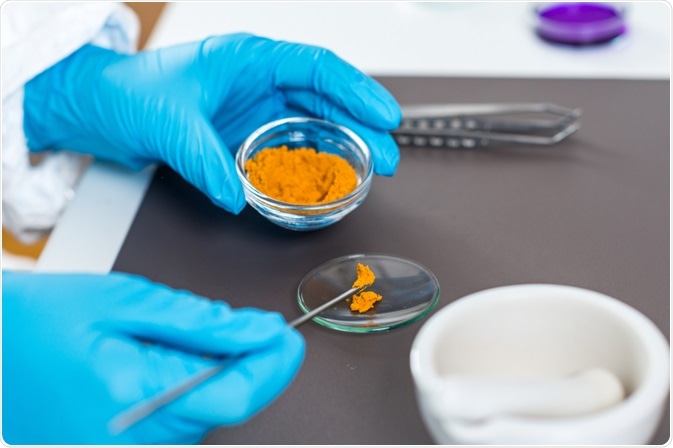A group, led by Professor Yousefi at the University of Medical Sciences, Iran, has examined the effect of a nano range formulation of the naturally occurring curcumin in the treatment of the arthritis subtype ankylosing spondylitis (AS).
 Image Credits: Microgen / Shutterstock.com
Image Credits: Microgen / Shutterstock.com
They found that T reg cells, which suppress the immune system, were significantly upregulated in AS patients receiving a 4-month nanocurcumin dose. Specifically, curcumin was able to enhance Treg differentiation.
What is nanocurcumin
Curcumin is a yellow naturally occurring substance found in turmeric. Its benefits include antioxidant, immunomodulatory, and anti-inflammatory properties. Curcumin, however, is poorly soluble in water, shows low oral bioavailability, is eliminated from the body rapidly, and is metabolized quickly.
Consequently, in this form, curcumin has poor clinical application. To overcome these issues, biodegradable polymer nanoparticles have been developed as a conduit for administration. This resulting nanocurcumin enhances both the solubility and stability of curcumin, as well as promoting free radical scavenging through formulaic additions of vitamins and minerals.
While curcumin has been the subject of a wide range of clinical studies, nanocurcumin’s biological activity is poorly understood. In the context of AS, its mechanism of action has rarely been discussed.
Determining a protocol for nanocurcumin delivery
To gain a better understanding of the role of nanocurcumin in the treatment of AS, 12 patients which treated with a dose of 80mg/kg over a period of 4 months. To determine the effects on the system, the rate of regulatory T cell production (Treg) and the miRNAs associated with the expression profile of cytokines were measured.
Previous research that has posited that Treg cells play an essential role in immune system suppression, provided the rationale behind the examination of these cells in this study. Specifically, Treg populations are significantly downregulated in AS.
Treg upregulation in response to nanocurcumin
The team subjected the peripheral blood (PB) of AS patient to flow cytometric analysis to quantify the change in population size in response to nanocurcumin. Yousefi et al. found that this increasingly bioavailable version of curcumin significantly increased the percentage of Treg cells present in PB relative to the placebo group. Concomitant with the upregulation of Treg was an increase in the expression of the translation factor FoxP3.
A secondary group of RNAS known as miRNA was also examined. miRNAs are non-coding and can regulate post-transcriptional gene expression. Two specific miRNAs, namely miR-17 and miR-27 were found to decrease. In addition, a corresponding increase in the miR-46a was determined in response to nano curcumin therapy.
The effect of Nanocurcumin in microRNAs, post-transcriptional regulators of Treg
miR-27 belongs to the family of miR-23~27~24 that is found to be upregulated in the Treg cells AS patients. this family is known to negatively regulate the expression of FoxP3 and the thymus-specific maturation process of Treg.
The effect of miR-27 is conflicting; its excessive expression prevents the Th2 response, which results in pathogenic Th1 immunity that exacerbates systemic inflammation.
miR-17 Is an additional negative regulator of Treg suppression. It exerts its effect by decreasing the expression of Co transcriptional regulators and FoxP3. Collectively, they control the phenotype of Treg.
Subsequently, decreasing miR-27/-17 is thought to maintain the normal differentiation of Treg cells and stimulate their suppressive activity.
miR‐146a, by contrast, is associated with Treg‐mediated suppression. The signal transducer and activator transcription 1(STAT1) is increased in expression in the absence of miR-146a. This miRNA targets STAT1; without it, miR-146a induces the proinflammatory phenotype of Treg.
Following treatment with nanocurcumin, increased expression of miR-146a results in dampening of the Th1 response, by ensuring that STAT1 expression is maintained within the optimal range. This results from a reduction in the Treg proinflammatory phenotype.
Targeting of cytokines to reduce inflammation
The cytokines IL‐10 and TGF‐β were found to increase while IL-6 decreased in patients receiving nanocurcumin relative to their placebo counterparts. In the absence of appropriate IL-10 regulation, the inflammatory response is exacerbated. This augmentation is implicated in several autoimmune diseases and this is exerted by either indirect or direct effects on Treg.
TGF‐β is pleiotropic, producing multiple effects. As a result of promoting differentiation and survival of Treg cells, inhibiting self-reactive T-cell proliferation and inducing tolerance of T-cell against autoimmune disease, TGF‐β’s regulatory role is more pronounced relative to its inflammatory action.
IL‐6 works to inhibit Treg expression induced by TGF‐β‐ and promotes the differentiation of Th17 cells. As the ratio of Th17/Treg is increased in AS, the reduced secretion of IL-6, together with increased IL‐10 and TGF‐β resulting from nanocurcumin treatment suggests FoxP3 is the target of the compound. Specifically, nanocurcumin upregulates FoxP3 expression.
The team concluded by asserting that follow-up studies are necessary to determine which pathways are regulated by nanocurcumin. The results of the study have demonstrated that nano curcumin shows potential therapeutic capability in AS patients as a result of its immune response modification. Specifically, it enacts its anti-inflammatory effects by altering the phenotype of key immune responses and stimulating anti-inflammatory mediators.
Source
Yousefi, M et al. (2020) The effects of nanocurcumin on Treg cell responses and treatment of ankylosing spondylitis patients: A randomized, double‐blind, placebo‐controlled clinical trial. J. Cell. Biochem, doi: 10.1002/jcb.28901
Further Reading
Last Updated: Mar 12, 2020